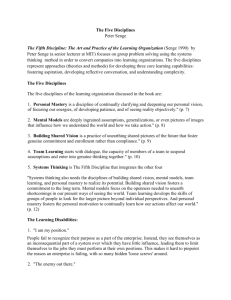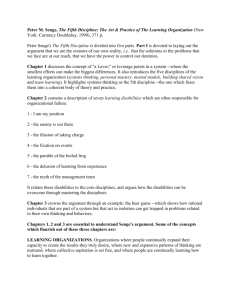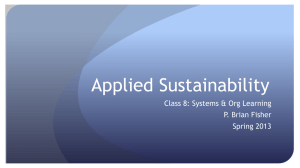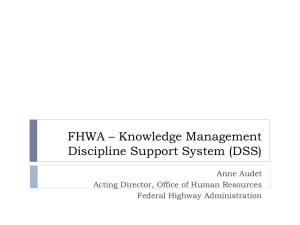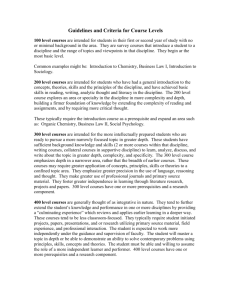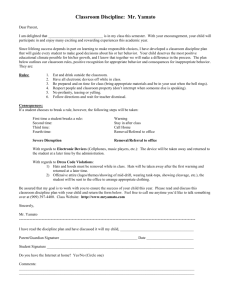Comprehensive Exam Study Guide The Fifth Discipline: The Art and
advertisement
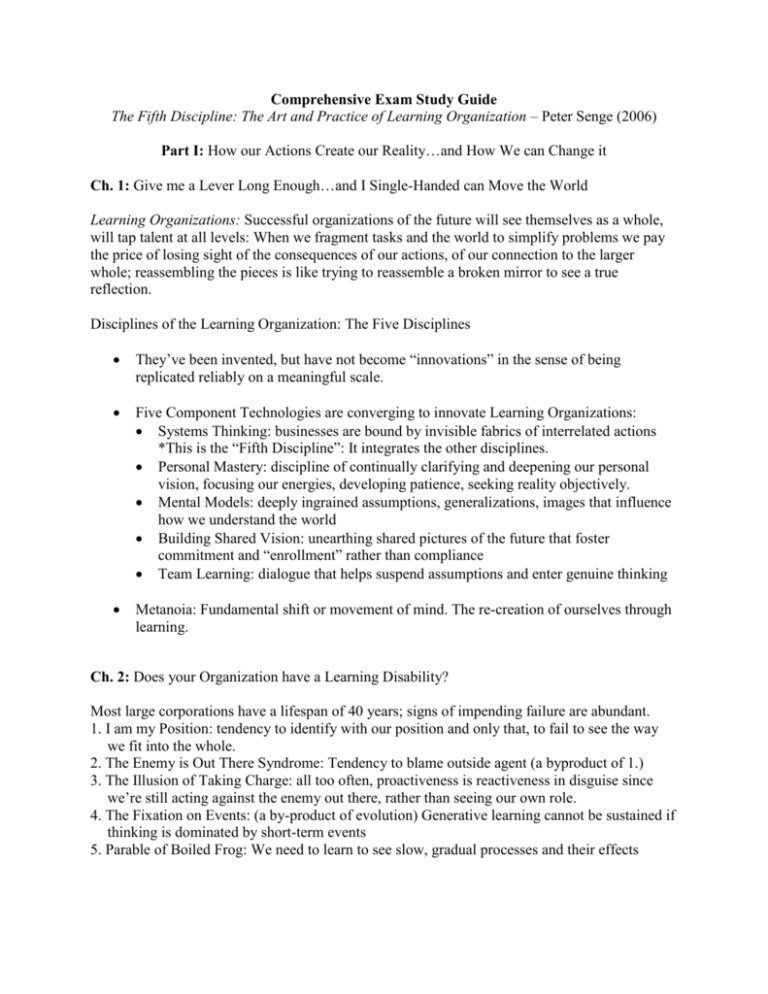
Comprehensive Exam Study Guide The Fifth Discipline: The Art and Practice of Learning Organization – Peter Senge (2006) Part I: How our Actions Create our Reality…and How We can Change it Ch. 1: Give me a Lever Long Enough…and I Single-Handed can Move the World Learning Organizations: Successful organizations of the future will see themselves as a whole, will tap talent at all levels: When we fragment tasks and the world to simplify problems we pay the price of losing sight of the consequences of our actions, of our connection to the larger whole; reassembling the pieces is like trying to reassemble a broken mirror to see a true reflection. Disciplines of the Learning Organization: The Five Disciplines They’ve been invented, but have not become “innovations” in the sense of being replicated reliably on a meaningful scale. Five Component Technologies are converging to innovate Learning Organizations: Systems Thinking: businesses are bound by invisible fabrics of interrelated actions *This is the “Fifth Discipline”: It integrates the other disciplines. Personal Mastery: discipline of continually clarifying and deepening our personal vision, focusing our energies, developing patience, seeking reality objectively. Mental Models: deeply ingrained assumptions, generalizations, images that influence how we understand the world Building Shared Vision: unearthing shared pictures of the future that foster commitment and “enrollment” rather than compliance Team Learning: dialogue that helps suspend assumptions and enter genuine thinking Metanoia: Fundamental shift or movement of mind. The re-creation of ourselves through learning. Ch. 2: Does your Organization have a Learning Disability? Most large corporations have a lifespan of 40 years; signs of impending failure are abundant. 1. I am my Position: tendency to identify with our position and only that, to fail to see the way we fit into the whole. 2. The Enemy is Out There Syndrome: Tendency to blame outside agent (a byproduct of 1.) 3. The Illusion of Taking Charge: all too often, proactiveness is reactiveness in disguise since we’re still acting against the enemy out there, rather than seeing our own role. 4. The Fixation on Events: (a by-product of evolution) Generative learning cannot be sustained if thinking is dominated by short-term events 5. Parable of Boiled Frog: We need to learn to see slow, gradual processes and their effects 6. The Delusion of Learning from Experience: The problem is that we learn best from experience but rarely experience directly the consequences of our most important decisions. Corporations often break into component, which then become their own “fiefdoms.” 7. The Myth of the Management Team: All too often, they just fight for turf and break down under pressure Disabilities and Disciplines: History shows that empires collapse surprisingly quickly; they sense that all is not right, but they defend the same old ways of doing things. Ch. 3: Prisoners of the System, or Prisoners of our own Thinking The Beer Game: a song/video makes Lovers’ Beer popular. Retailers order exponentially, manufacturers and wholesalers get backlogged with orders; demand finally drops off and manufacturers/wholesalers/distributors/retailers left with a backlog, and each blames another. Lessons: 1. Structure influences behavior: different people within same structure tend to blame the other even though systems tend to create their own crises. 2. Structure in human systems is subtle: structure in human systems is usually organic, not simply a constraint on the individual. We tend to miss the inter-relatedness of parts. 3. Leverage often comes from new ways of thinking: people lose leverage by focusing only on their own role, rather than on how they fit into a whole of other parts. Part II: The Fifth Discipline: The Cornerstone of the Learning Organization Ch. 7: Self-limiting or Self-sustaining Growth The principle of leverage is generally accepted; but in real-life systems, it is not obvious b/c of our non-systemic way of thinking. We focus on symptoms, rather than on structures underlying our actions. Systems archetypes help us see the structures and find the leverage. When We Create our Own Market Limitations: Real-life Story of Wondertech 1980s electronic company produces high-end computer whose sales double annually for 3 years, but thereafter declines into bankruptcy: promised 8-week delivery took 14, new factory was built and new salespeople hired. When sales slumped, the Sales/Marketing VP reorganized and pressured his team to “sell, sell, sell.” Sales recovered, but the cycle repeated itself and he eventually lost his job. The cycles caused panic and the company made ill-conceived improvements out of fear of competitors until it collapsed: this is typical (5/10 companies disappear in first five years; 4/10 survive ten years; and only 3/10 survive to 15 years) The systemic component that caused the decline was long delivery times due to backlogged orders: they made the mistake of “pushing hard on the reinforcing process” through sales promotion, which gave no leverage toward delivery time. They ignored the balancing process, where the leverage lies in a limits-to-growth structure. Classic shifting of the burden structure: The symptom (delivery time) worsened, and the overall health of the company worsened; feeling of victimization grew; slow to recognize the correct symptom, they focused on declining orders only, but adding manufacturing capacity didn’t improve delivery time; customers walked away. The point of leverage that was ignored was the firm’s original commitment to fast delivery. Seeing the Forest AND the Trees: “Growth and Underinvestment” Archetype: When a company limits its own growth through underinvestment (by building less capacity than is needed for customer demand, as with Wondertech): it becomes vulnerable to foreign competition and is hard to see for 2 reasons: The process is so gradual, that the company erodes (boiled frog syndrome) Managers in the middle deal with so many urgencies, they are unequipped to see the large patterns at work The goal is to master the basic archetypes, such as “growth and underinvestment” in order to see the way that smaller components fit into the larger patterns. Part III: The Core Disciplines: Building the Learning Organization Ch. 8: Personal Mastery (the discipline of personal growth and learning) Organizations learn only through individuals who learn: renewed commitment to “radical rethinking of corporate philosophy which a commitment to individual learning requires.” Kazuo Inamori (founder of Kyocera) – “the active force is people…” Bill O’Brien (Hanover Insurance) – organizational models congruent with human nature…for [their] higher order needs, self-respect, and self-actualization Managers must give up old dogma of planning, organizing, controlling and realize their sacred responsibility toward so many lives. Mastery and Proficiency - means two things: continually clarifying what is important to us and continually learning how to see current reality more clearly. It means a special level of proficiency, rather than dominance over others. Why We Want It: People with high levels of personal mastery are more committed and take more personal initiative, have a broader and deeper responsibility. “We want it because we want it.” Resistance: It is a soft an non-quantifiable concept Cynicism It threatens the established order of a well-managed company The Discipline of Personal Mastery: Approaching it as a series of practices and principles Personal Vision: Real vision is the ability to focus on ultimate intrinsic desires, not only on secondary goals. Vision cannot be isolated from the idea of purpose, but it is also different from purpose (Purpose is a direction, while “vision” is a destination). Those without purpose have no sense of appropriate scale Vision is intrinsic, not relative Vision is multi-faceted Holding Creative Tension: the force that comes into play the moment we acknowledge a vision that is at odds with current reality. The emotional tension of negative emotions like anxiety is not the same as creative tension, though they may be present and we need to be able to live with them. The gap between vision and reality can be resolved in two ways: Taking actions to bring reality in line with the vision Lowering the vision to accord with the reality Mastery of creative tension leads to a fundamental shift in our whole posture toward reality. “Structural Conflict”: The Power of Powerlessness - According to Robert Fritz, people hold one of two contradictory beliefs about the ability to create what we want: Powerlessness – that we are unable to bring about the things we care about Unworthiness – that we don’t deserve what we desire These form “structural conflict” – two conflicting forces, one pulling us toward our vision and the other (powerlessness/unworthiness) holding us back. We often fall back on 3 generic strategies to deal with the conflict: Letting our vision erode Conflict manipulation: we try to manipulate ourselves into greater effort by creating artificial conflict (mobilizing ourselves through fear) Willpower Commitment to the Truth: the answer lies in recognizing the structural conflict so that they don’t hold us prisoner Using the Subconscious, or You Don’t Really Need to Figure it All Out: developing a rapport between normal awareness and subconscious. We have mastered skills that have become unconscious (e.g. driving) Exercise for focusing more clearly on desired results: imagine the goal realized and ask, “If I had this, what would it get me?” and then hold that answer as part of your vision now. The subconscious responds to a clear focus (Imagery and Visualiztion) Personal Vision and the Fifth Discipline: Integrating Reason and Intuition Seeing our Connectedness to the World Compassion Commitment to the Whole The Core Leadership Strategy for an Organization: Be a model by committing to your own personal mastery. Ch. 9: Mental Models Why the Best Ideas Fail: they fail to get translated into action; systemic insights don’t find their way to operating polities – they conflict with prevailing mental models Our mental models determine how we make sense of the world and what action we take. GMs mental model was that Americans care most about style and that cars are primarily a status symbol – but this model outran its usefulness Incubating a New Business Worldview: Shell Oil executives planned for the “new world” after the 1970s oil crisis and OPEC and went from the weakest to one of the strongest oil companies. BP provides another example Working with Mental Models in Practice: 3 facets to developing an organization’s capacity to test mental models: Tools that promote personal awareness and reflective skills Infrastructures that institutionalize regular practice with mental models A culture that promotes inquiry and challenging our thinking Overcoming “the Basic Diseases of the Hierarchy”: the new dogma of vision, values, and mental models (section of pages discussing implementation, not outlined here). Mental Models and the Fifth Discipline: research shows that most of our mental models are systemically flawed; our mental models must consider the whole system as well. Ch. 10: Shared Vision
